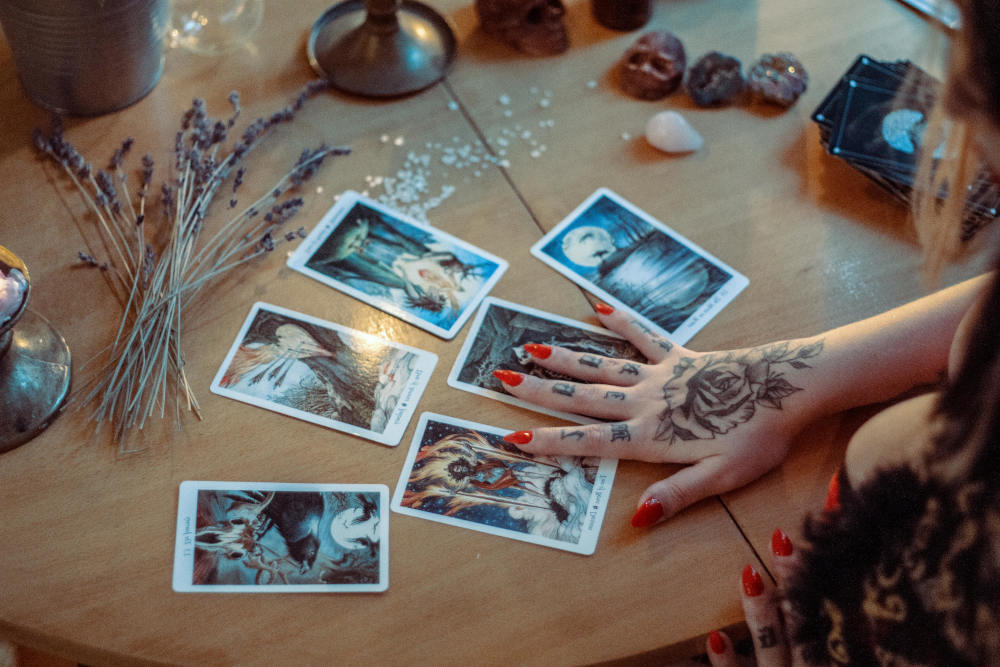
Choosing your first tarot deck is a deeply personal and often exciting journey. With hundreds of options available—ranging from classic to modern, minimalist to richly illustrated—it’s easy to feel overwhelmed as a beginner. But finding the right tarot deck isn’t about choosing the most popular or the most expensive one. It’s about finding a deck that resonates with you—your intuition, your learning style, and your personal energy.
This article will guide you through the process of choosing your first tarot deck, explain the different types of decks, and provide tips to help you confidently begin your tarot journey.
Panaprium is independent and reader supported. If you buy something through our link, we may earn a commission. If you can, please support us on a monthly basis. It takes less than a minute to set up, and you will be making a big impact every single month. Thank you!
What Is a Tarot Deck?
A tarot deck is a set of 78 cards used for divination, spiritual insight, or personal development. Each deck consists of:
-
22 Major Arcana cards: Representing life’s spiritual lessons and big themes.
-
56 Minor Arcana cards: Representing daily experiences, emotions, and challenges. These are divided into four suits (Wands, Cups, Swords, and Pentacles), each with 14 cards (10 numbered and 4 court cards).
While the structure remains consistent, the art, symbolism, and interpretations can vary significantly between decks. That’s why choosing the right one matters.
Step 1: Understand the Different Types of Tarot Decks
Before you shop for a tarot deck, it’s important to know the main styles or systems:
1. Rider-Waite-Smith (RWS)
-
Most beginner-friendly and widely used system.
-
Created in 1909 by Arthur Edward Waite and artist Pamela Colman Smith.
-
Rich with clear imagery, symbolism, and accessible guidebooks.
-
Many modern decks are based on this structure.
-
Best for beginners because of the extensive learning resources available.
2. Thoth Tarot
-
Created by Aleister Crowley and painted by Lady Frieda Harris in the 1940s.
-
Complex, esoteric, and based on Thelema, astrology, and Kabbalah.
-
Powerful imagery but not ideal for complete beginners.
3. Tarot de Marseille
-
One of the oldest tarot systems with woodcut-style art.
-
Minor Arcana cards are “pip cards,” meaning they show numbers and suits without illustrated scenes.
-
Better for intuitive or numerology-based readings.
Tip for beginners: Start with an RWS-based deck unless you feel a strong pull toward another system.
Step 2: Let Your Intuition Lead
Tarot is a tool of intuition, and choosing a deck should start the same way. Look through images of different decks online or in person. Ask yourself:
-
Do the images speak to me?
-
Do I feel curious, comforted, or inspired?
-
Does the deck feel like something I’d enjoy spending time with?
You don’t need to understand every symbol at first. What matters is whether the art connects with you emotionally or visually.
Step 3: Consider the Artwork and Style
The artwork sets the mood for your readings. Some decks are whimsical, others dark, spiritual, modern, or nature-based. Think about what draws you in:
-
Do you prefer realistic art or abstract design?
-
Are you drawn to bright colors or earthy tones?
-
Do you want a deck with diverse representation, inclusive characters, or mythical creatures?
A deck with clear and expressive artwork can help you interpret meanings more easily—especially in the beginning.
Step 4: Think About the Theme or Purpose
Some tarot decks are designed around a specific theme or cultural system, such as:
-
Nature and animals
-
Astrology or moon phases
-
Greek, Norse, or Egyptian mythology
-
Feminist, LGBTQ+, or spiritual empowerment themes
Choosing a theme that reflects your interests can deepen your connection with the cards. If you're spiritual, artistic, or drawn to specific symbols (like the moon or wolves), choose a deck that aligns with those interests.
Step 5: Read Reviews and Descriptions
Before buying a deck, look up reviews, walkthroughs, or flip-through videos. This will help you understand:
-
Card quality and size (are they too big or too small for your hands?)
-
Guidebook quality (is it beginner-friendly and clear?)
-
Card back design (can you reverse them for reversed meanings?)
-
How shufflable the cards are (some decks are stiff or glossy)
YouTube and tarot review blogs are great resources for seeing the cards in action.
Step 6: Check the Guidebook
A beginner-friendly guidebook is essential. Many decks come with a “little white book,” but not all are equally helpful. As a beginner, look for a guidebook that includes:
-
Clear upright and reversed meanings
-
Explanation of symbols or imagery
-
Tips on how to do readings or spreads
-
Exercises or journal prompts
Some beginner decks, like The Modern Witch Tarot or The Light Seer’s Tarot, come with full-color, detailed guidebooks.
Step 7: Decide Where to Buy
You can buy tarot decks at:
-
Local metaphysical shops: You get to touch the cards and see them in person.
-
Online retailers: Amazon, Etsy, and specialty tarot sites like The Tarot Garden or Little Red Tarot offer many choices.
-
Direct from creators: Many indie decks are available through Kickstarter or artist websites.
Note: The old myth that your first tarot deck must be a gift is outdated. It’s perfectly fine—and empowering—to buy your own.
Step 8: Choose Between Mass-Market and Indie Decks
Mass-Market Decks:
-
Widely available in stores or online
-
More affordable (usually $20–30)
-
Often published by big companies like U.S. Games or Hay House
Indie Decks:
-
Self-published by artists or small creators
-
More unique and artistic
-
More expensive ($40–70+), but often higher quality and ethically produced
If you're a beginner, a mass-market deck may be more practical, but if a specific indie deck speaks to you, don’t be afraid to follow that call.
Step 9: Consider the Card Size and Feel
Card size matters more than you might think. Some decks are oversized with large art but hard to shuffle. Others are compact and great for travel. As a beginner, choose a deck with:
-
Standard tarot size (about 2.75 x 4.75 inches)
-
Matte or semi-matte finish (less slippery)
-
Durable cardstock that won’t wear out quickly
If your hands are small, you might want a deck labeled “pocket” or “mini.”
Step 10: Start With a Classic If You’re Unsure
If you still feel unsure, start with one of these beginner-friendly decks:
1. Rider-Waite-Smith (original)
-
The classic deck with recognizable symbolism
-
Affordable and comes with many resources online
2. The Modern Witch Tarot
-
A diverse, feminist twist on the RWS deck
-
Comes with a detailed guidebook
3. The Light Seer’s Tarot
-
Popular for its intuitive, emotional art
-
Great for modern readers who want a soulful vibe
4. Everyday Tarot
-
Compact and minimal
-
Great for journaling and daily pulls
Final Tips for Beginners
-
Cleanse your deck when you first receive it by smudging, knocking on it, or placing it under moonlight.
-
Store it with care, either in the box, a pouch, or on your altar.
-
Practice regularly. Pull a daily card to get familiar with meanings.
-
Journal your readings to track your growth and intuitive insights.
-
Be patient. It takes time to build a relationship with your deck.
Conclusion
Choosing your first tarot deck is an invitation to explore your inner world, intuition, and creativity. There’s no “right” deck for everyone—just the right deck for you. Trust your instincts, explore different styles, and don’t stress over making the perfect choice. The right deck will feel like an old friend you’ve finally met.
Whether you’re drawn to classic symbolism, mystical artwork, or playful themes, your tarot journey begins the moment you choose the deck that speaks to your soul.
Was this article helpful to you? Please tell us what you liked or didn't like in the comments below.
About the Author: Alex Assoune
What We're Up Against
Multinational corporations overproducing cheap products in the poorest countries.
Huge factories with sweatshop-like conditions underpaying workers.
Media conglomerates promoting unethical, unsustainable products.
Bad actors encouraging overconsumption through oblivious behavior.
- - - -
Thankfully, we've got our supporters, including you.
Panaprium is funded by readers like you who want to join us in our mission to make the world entirely sustainable.
If you can, please support us on a monthly basis. It takes less than a minute to set up, and you will be making a big impact every single month. Thank you.































0 comments